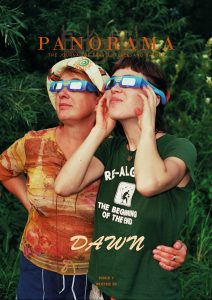When the clusters of round green fruits peek out from under the broad leaves of the santol tree in our yard, I am filled with a sense of expectation. I know that the tree is turning soft like a woman easing into motherhood with a rounded belly and is preparing to turn the green orbs into yellow-orange fruits in June, around two months from now, just towards the tail-end of the Philippine summer.
While we wait for them to ripen, my sister and I spend our days running circles around the trunk. It’s stout as most ancient trees are, but thin for the amount of foliage it supports. The branches stretch out wide and the leaves fan forth from them in a huge canopy, and from afar, the trunk looks like a matchstick holding up a green clown wig.
Caterpillars start to crawl out from their hiding places within the branches, their brown fuzz making them look as if they have emerged from the santol tree’s bark itself. They inch along at a contemplative pace, unfazed by the laughter and shouts we ring out in the air. Sometimes, we would find a caterpillar that has fallen onto our shoulders, and we brush them off frantically. Just a few minutes later, angry red welts would appear on our arms, the caterpillar having shed a few of its brown bristles onto our smooth young skin. We rush back into the house to run our arms under the tap, savoring the way the water washes away the summer heat and the caterpillars’ revenge for disturbing their peace.
Beside the santol tree is a huge metal frame from which hang two swings. They are slabs of wood tethered to the frame with thick solid chains, and we twist round and round until the chains are in a gnarly knot, and then we let go, unfurling in a blur of hair and arms and legs. When we get tired of this, we take turns pushing each other on the swing and watch the other go whipping through the wind as high as she can.
We are only a year apart, my sister and I. But we look as if the age difference is bigger than it is because she’s three inches taller and three sizes larger than me. We look and act as if every day is Opposite Day. Her skin is fair while mine is dark, and this could explain why she is my dad’s favourite, because his family is distinctly Spanish in appearance and bearing. This must be why she lives with him while I live with my mother, whom I take after, with my short stature and brown skin, making me look like an indio instead of a mestiza. Her voice is strong and strident, while mine is tremulous, and I rarely speak above a whisper. Her movements are decisive, while mine are tentative. Perhaps the only thing that could be said we share is how disjointed we feel. Most of the time, she is angry, often lashing out at the slightest sign of my mother’s scolding, and I am prone to bouts of sadness. But this is expected, the childhood experts we’ve visited say, we are textbook children of divorce.
But none of these matters to us during this summer, when I am eight and she is nine, when every day dawns with the promise of adventure. Under the sweltering sun, our skins both burn as we skip and tumble around the huge yard that plays host to many native trees. We dangle upside-down from the branches of the guava tree and reach for the low-lying guavas hanging from its pale, smooth branches. I hate its bitter taste, but she loves crunching through the waxy green skin to reach the pale pink pulp inside. Sometimes we pick them for our grandmother to use when she cooks sour milkfish soup.
Our house, that is, our grandmother’s house, sits among a circle of these native trees. Behind it are two other trees – a study in contrasts, like my sister and me. The macopa stands high with full dark green leaves cascading down to the earth, laden with ripe pink bells that sway merrily in the breeze. It is a beautiful, bountiful sight – a tree of plenty, never mind if the fruit itself is tasteless, and is only saved by the charm of its curves, its sides flaring into a bell and then the bottom gathering back inside like the graceful hem of a princess’s ball gown.
Beside it is the siniguelas, a somber, sobering vision, paling, almost withering, beside the beauty of the macopa tree. It is light of leaf and looks sparse and barren, as if it is perpetually wintering. The branches jut out in stiff, awkward sticks. Dotted here and there among them are small brown, dull green and maroon plums that the tree holds up as a disgruntled contribution to the summer landscape. The skin of the plum stretches tightly around its seed, as if holding back a secret, unwilling to show its essence. Even its seed is a mirror of this barrenness – it cannot give birth to a new tree, and so the siniguelas can only be grown through cuttings. For some reason, the tree looks best at dusk, when its silhouette seems to soften and blend into the darkening sky.
At night, the cashew tree in front of the house suddenly wakes up and breathes out its pungent morning breath. It is a nocturnal creature, and so it has no idea that we pluck its fruits in the morning, the warm yellow cups dropping gently into the net at the end of our long wooden sticks. Or maybe it does, but it’s too sleepy to protest. Once dusk settles, it comes alive and the flowers send out a siren aroma, perhaps to lure back into the fold, or else to mourn, the fruits now lying in my grandmother’s basket. We prise the gray nuts off one by one and plunk them in a bowl that she would take out in the sun the next day to dry. She then slices the fruits themselves into slender pieces for dipping in rock salt.
We pass the months like this until finally, as the soft patter of June rain arrives, the santol tree drops its first ripe fruits on the ground. The green rind has turned yellow-orange streaked with brown, and there are brown dots just like the age spots on our grandmother’s hands. The peel is tough and leathery but covered with soft hair. Some of them burst open as they fall to the ground, split apart like us. My sister grabs one, and digs her fingers into the soft, white, star-shaped flesh that swells out from the center. Her face crunches up at its sourness, and she spits out the seeds onto the sodden ground. I merely look on. I’ve learned early enough in life that I don’t have a taste for sour fruits.
And just like that, we know that the summer has come to an end, and we must say goodbye again soon. We’ll see each other in school a few weeks later, and wave across the hallways in between classes. The next time she’ll be back in our house will be on her birthday two months from now, and by then the rains will have been in full force, and we would just have to watch from the windows the swings dancing in the wind without us.
When I think about it, none of our trees bear that most glorious fruit of tropical summers – the mango. In fact, we often sigh at the sight of our neighbour’s towering mango tree, its bright yellow fruits hovering over the fence to taunt us, too high for us to reach even with a stick. How we wish we had mangoes at our beck and call! But this is life, our life – where the rupture of our little family has rendered most of our days sour or bitter or otherwise tasteless, and the sweet moments come few and far between – and we make do with what we have. We swing and reach for the treetops, and we laugh and do cartwheels just the same because as long as we have each other, for however short a time, it doesn’t feel like making do at all.











